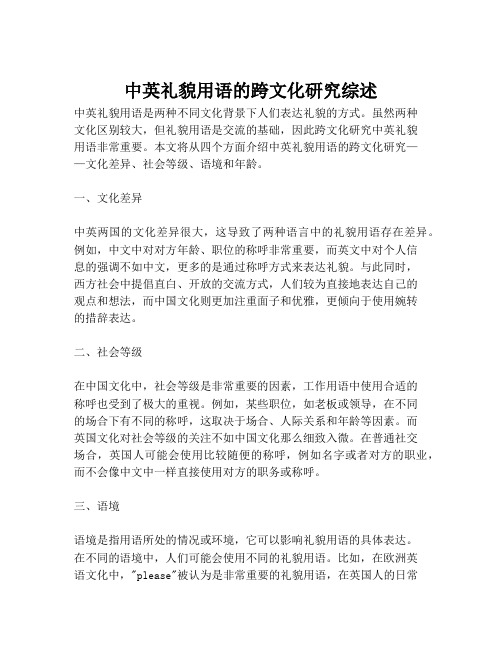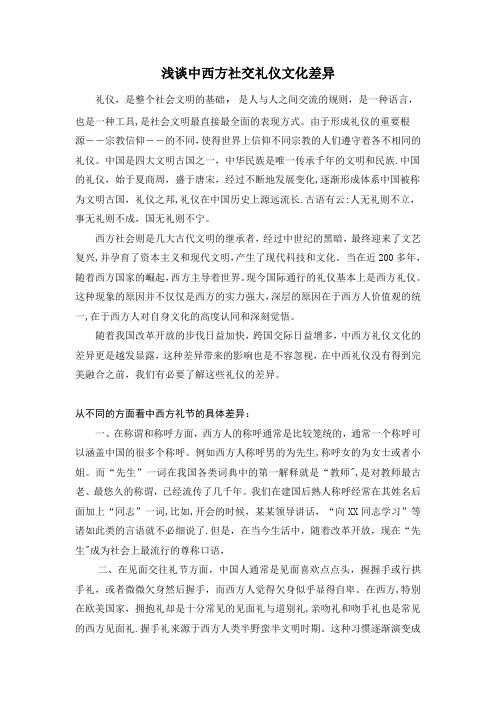中西文化下的礼貌用语分析
中西方礼貌用语对比分析

中西方礼貌用语对比分析 英语专业全英原创毕业论文,是近期写作,公布的题目可以用于免费参考 最新英语专业全英原创毕业论文,都是近期写作
1 《大衣》中定语从句的翻译策略 2 英汉职业委婉语中“礼貌原则”之对比分析 3 福克纳小说中的圣经意象 4 罪与同情—论齐林沃斯的悲剧 5 英语中法语外来词对英国文化的影响 6 An Analysis of Memoirs of a Geisha from the Perspective of Existentialist Feminism 7 浅析不同文化中的身势语 8 The Improvement of English Learning Skills Through Nursery Rhymes 9 论《红字》里“A”字的象征意义 10 从《嘉莉妹妹》看美国梦与道德观 11 网络流行语翻译评析——“神马都是浮云”个案分析 12 性格、学习策略和英语学习成绩的关系研究 13 关联理论关照下文化缺省现象及其翻译应对策略 14 A Brief Study of Rhetorical Devices Employed in President Obama’s Inaugural Address--from the Perspective of 英语专业全英原创毕业论文,是近期写作,公布的题目可以用于免费参考 Syntactic Structure 15 论海明威作品中的语言特征 16 由英语外来词谈中英文化 17 从“房间”意象看英国当代社会悲剧——哈罗德•品特作品解读 18 《了不起的盖茨比》中的象征 19 中西方悲剧爱情故事折射出的文化差异—《穆斯林的葬礼》与《荆棘鸟》之比较 20 从女性主义视角看《蝴蝶梦》 21 Miss Havisham: an Imprisoned Woman in Great Expectations 22 写作教学中的范文教学 23 女性哥特视角下的《蝴蝶梦》 24 论格列佛人物形象在《格列佛游记》中所起的讽刺效果 25 书面语言输入与输出对英语词汇习得的影响 26 On the Unique Narrating Methods and Writing Skills in Brideshead Revisited 27 《弗洛斯河上的磨坊》中麦琪悲剧原因分析 28 残酷的现实与审美愉悦——论《罗密欧与朱丽叶》的崇高美 29 外国品牌中译的创新翻译研究 英语专业全英原创毕业论文,是近期写作,公布的题目可以用于免费参考 30 浅谈礼仪在商务谈判中的重要性及其相关策略 31 中美时间观的文化差异 32 英语单位名词研究——以《牛津高阶英汉双解词典(第六版)》为例 33 论《野性的呼唤》的多重主题 34 A Study of the Personality of Emily from A Rose for Emily 35 英语经济新闻标题翻译在模因传播中的分析 36 《了不起的盖茨比》和美国现代社会 37 《看管人》下的“品特式”( 开题报告+论) 38 从《好事一小件》和《洗澡》的对话对比分析看人物形象塑造的差异 39 浅析科技英语翻译中的逻辑错误 40 论旅游英语的语言学特征 41 《雾都孤儿》中的反犹主义 42 Western and Chinese Marriage Differences in Cross-cultural Communication 43 A Study of Humour And Satire in Mark Twain’s Two Famous Adventures 44 从托妮莫里森透析世纪黑人民族意识演变 45 《等待戈多》中的矛盾分析-分裂的语言与互英语专业全英原创毕业论文,是近期写作,公布的题目可以用于免费参考 补的人物 46 论《霍华德庄园》中的象征主义 47 《紫色》中的隐喻语篇功能探索 48 学习动机对大学生英语学习的影响 49 论英语商务合同中状语从句的翻译 50 试析中英婚姻生活差异及其原因 51 王尔德唯美主义对现代消费文化的启示--以《道林格雷的画像》为例 52 从跨文化交际看中西方时间观差异 53 文化商务交际中的个人主义与集体主义 54 卡森•麦卡勒斯《心是孤独的猎手》福柯式解读 55 《德伯家的苔丝》苔丝和《红字》海斯特的悲剧命运的比较 56 从数字的联想意义研究中西文化的差异 57 萧伯纳的费边思想在芭芭拉少校中的体现 58 Analysis of the Individual Heroism in the American Movies 59 The Alternation of Language: A Study of Microblogging Vocabulary 60 论《最后的莫西干人》中的印第安情结 61 象征主义视角下《致海伦》中的意象美 英语专业全英原创毕业论文,是近期写作,公布的题目可以用于免费参考 62 《哈克贝里·费恩历险记》中哈克和吉姆的人物形象分析 63 从王尔德喜剧中的花花公子形象解读王尔德信奉的纨绔主义 64 《呼啸山庄》爱情悲剧根源分析 65 从《美国的悲剧》解析美国梦 66 On Moral Characters in The Picture of Dorian Gray 67 从美国汽车看美国文化 68 以姚木兰和斯嘉丽为例看东西方女性意识差异 69 析《远大前程》主人公匹普的性格成长历程 70 用隐喻理论分析英汉商标的语言特色 71 试论《围城》中四字成语的英译 72 《了不起的盖茨比》中乔丹•贝克的人物分析 73 被忽略的人群--詹姆斯乔伊斯《都柏林人》女性角色分析 74 从《少年派的奇幻漂流记》论人性与兽性 75 交际教学法在中学英语课堂中的应用 76 阿加莎克里斯蒂侦探小说中的罪犯形象 77 The Application of Corpus in Teaching English Reading 英语专业全英原创毕业论文,是近期写作,公布的题目可以用于免费参考 78 中英社交禁忌习俗异同之比较分析 79 对《大地》中女性人物的生态女性主义解读 80 论《瓦尔登湖》的生态伦理意蕴 81 任务型教学在初中英语的实施情况研究 82 高中英语课堂教学中的口语教学 83 论英语课堂教学中的非语言交际 84 浅谈汉语成语的英译 85 英语国家姓氏文化研究 86 解析《老人与海》中的桑提亚哥形象 87 庞德诗歌《在地铁站里》的意象分析 88 Strategies of Translating Chinese Proper Nouns in Tourism Texts 89 英语广告中仿拟的关联分析 90 侦探小说的发展 91 突破桎梏——《紫色》的生态女权主义视角解读 92 《劝导》中安妮•艾略特的道德判断 93 从隐喻视角解析《黄墙纸》的疯癫意象 94 社会实践活动对大学生的重要性 95 用陌生化理论阐述《红色手推车》的悲剧色彩 96 诸神形象折射中西方价值观不同 97 论小说《看不见的人》中的象征主义 英语专业全英原创毕业论文,是近期写作,公布的题目可以用于免费参考 98 A CP-based Analysis of Humor in Friends 99 从《卡斯特桥市长》看哈代作品中的宿命论色彩 100 试论用英语电影进行英语文化教学 101 高中英语词汇课堂教学策略 102 男女二元等级对立的颠覆--《奥兰多》之女性主义解读 103 论《简爱》中话语的人际意义 104 A Comparison between Scarlett O’Hara and Jane Eyre from the Perspective of Feminism 105 从动态对等角度论英语俚语的翻译 106 目的论视角下公益广告的翻译 107 《嘉莉妹妹》中女主人公的服饰所反映的女性意识 108 中西方传统习俗的对比研究——出生礼,婚礼,葬礼 109 《海的女儿》中安徒生的悲剧情结分析 110 从时代背景看《唐璜》中个人主义到人道主义的升华 111 从目的论角度讨论英语电影片名的翻译 112 美国品牌中国本土化进程中的文化冲突与英语专业全英原创毕业论文,是近期写作,公布的题目可以用于免费参考 融合 113 浅谈进口商品商标的翻译 114 探究中学生厌倦学习英语 115 文化意识与语言教学 116 《德伯家的苔丝》中亚雷形象分析 117 从语域和博客语篇角度解读博客传播 118 论身势语的跨文化交际应用 119 浅谈英汉文化差异对称呼语的影响 120 《了不起的盖茨比》中黛西的女性主义分析 121 永不凋落的玫瑰—从女性主义分析《红字》中的海斯特 122 “同一性危机”——浅析汉娜的悲剧人生 123 交际教学法在当前高中外语教学过程中的实效性 124 125 电影《死亡诗社》中的教育意义 126 论有效开展小学英语对话教学的策略 127 从莎翁作品透视伊丽莎白时期女性社会地位 128 商务英语新词构词研究 129 侠客精神和骑士精神折射出的文化差异—《七侠五义》和《亚瑟王之死》之比较
中西方表达时的礼貌原则

最使东西方不同文化背景的人们感到困 惑的是双方在别人家做客后,告别时所 使用的礼貌用语存在惊人的差别,如西 方人会说: “Thank you so much for a wonderful evening”,而中国人会说: “实在不好意思,给您添麻烦了”(I am so sorry, I have given you so much trouble)。西方人使用感谢语来表示礼貌, 而中国人则使用道歉语来表示礼貌。仅 此一例,中西方礼貌原则的差异即可见 一斑。
我国学者顾曰国提出了中国文化中的礼 貌特征, 即尊重、谦逊、热情、文雅。
尊重, 就是自我尊重和赞赏对方; 谦逊, 表现为贬己尊人; 热情, 表现为关心、体贴、好客; 文雅, 指举止、谈吐得体大方。 礼貌原则具有普遍性, 世界各民族都有自 己的礼貌准则,具体表现在存在一定的差 异。笔者认为, 在中西方文化中礼貌表现 的差异, 主要有以下几个方面:
又如请求对方帮助, 在西方, 不管事大事 小, 不管对方与自己是上下级关系、师生 关系或亲属关系, 或别的什么关系, 都会向对方表达感激, 说“Thank you”, 否则就是不礼貌的。中国人则不一样, 一 是不常表达感激, 认为说“谢谢”是客气; 二是会区别事大事小和关系的上下、尊 卑、亲疏远近。一点小帮助, 无需客气; 上对下、尊对卑及亲属之间, 也无需客气, 因此在这些情况下, 一般都不说“谢谢”。
西方文化从古希腊开始就注重逻辑, 注重 分析, 重理性。亚里士多德把演说的篇章 概括为: 开头、提出问题、分析论证、结 尾。西方人的思维方式一般是直线形的,
说话、写文章习惯开门见山, 把话题放在 最前面, 先表达中心意思。中国人受儒家、 道家与佛教哲学思想和“天人合一”思想 的影响, 重视悟性和事物之间的联系, 所 以汉语重顿悟、讲含蓄, 语言有一定的模 糊性。中国人的思维方式以自觉、具体为 特征, 思维活动多是螺旋式地绕圈向前发 展。如中国人打电话, 通常开始都不谈自 己的意图、目的( 除了急事重大的事情 外) , 而总是谈些关心对方的话, 最后才说 出打电话的真正目的, 而西方人则习惯于 开门见山, 先说出打电话的目的和要谈的 正事, 然后再细说和谈些其它的事。
中英礼貌用语的跨文化研究综述

中英礼貌用语的跨文化研究综述中英礼貌用语是两种不同文化背景下人们表达礼貌的方式。
虽然两种文化区别较大,但礼貌用语是交流的基础,因此跨文化研究中英礼貌用语非常重要。
本文将从四个方面介绍中英礼貌用语的跨文化研究——文化差异、社会等级、语境和年龄。
一、文化差异中英两国的文化差异很大,这导致了两种语言中的礼貌用语存在差异。
例如,中文中对对方年龄、职位的称呼非常重要,而英文中对个人信息的强调不如中文,更多的是通过称呼方式来表达礼貌。
与此同时,西方社会中提倡直白、开放的交流方式,人们较为直接地表达自己的观点和想法,而中国文化则更加注重面子和优雅,更倾向于使用婉转的措辞表达。
二、社会等级在中国文化中,社会等级是非常重要的因素,工作用语中使用合适的称呼也受到了极大的重视。
例如,某些职位,如老板或领导,在不同的场合下有不同的称呼,这取决于场合、人际关系和年龄等因素。
而英国文化对社会等级的关注不如中国文化那么细致入微。
在普通社交场合,英国人可能会使用比较随便的称呼,例如名字或者对方的职业,而不会像中文中一样直接使用对方的职务或称呼。
三、语境语境是指用语所处的情况或环境,它可以影响礼貌用语的具体表达。
在不同的语境中,人们可能会使用不同的礼貌用语。
比如,在欧洲英语文化中,"please"被认为是非常重要的礼貌用语,在英国人的日常交流中十分常见。
而在中国文化中,虽然"请"也是表示礼貌的重点用语之一,但它的使用情境却与英语不尽相同。
除了称呼外,还需要关注听众的年龄、社会地位、性别等细节。
因此,在不同的语境中,如何选择合适的用语来表达礼貌至关重要。
四、年龄在中文文化中,对长辈的尊重是非常重要的传统,在怎么称呼一个人和如何表达谦卑方面有很多特别的用语和习惯。
年轻一代的中国人已经开始跟进西方的潮流,开始变得更加开放和直接,但在家庭环境中,尊重长辈的惯例仍然得到遵守。
而在英文文化中,虽然老年人的地位也是非常重要的,但在称呼方式和用语表达中,没有那么强调对长辈的尊重。
从跨文化交际的角度解读中西方礼貌准则和策略

从跨文化交际的角度解读中西方礼貌准则和策略解读中西方不同礼貌准则和策略,可以发现其实就是中西方思维方式的差异。
了解中西方礼貌准则,有助于中西方成功地进行文化交流,更有利于世界的和谐发展。
标签:跨文化交际;中西文化差异;礼貌准则作为人类文明的标志,礼貌是人类社会活动中的一条重要准绳,“是对交际行为的规范,是一种为进行得体交际的策略”(Claire,2005)。
礼貌是人际交往中不可或缺的前提条件,是打开交流者心灵的一把钥匙。
礼貌周全不仅可以增加别人对你的良好印象让你事半功倍,同时也是自我修养的一种体现,是自我素质的一种表现。
礼貌准则和策略的教育应该有意识的渗入到平时的外语教学中。
礼貌准则反映了一个民族历史与文化的积淀,蕴藏一个民族的文化价值、生活习惯以及思维方式。
在现代社会中,人际交往使得礼貌尤为重要。
由于生活环境、历史背景、传统习俗、价值观念、思维模式和社会规范等的不同,中西方礼貌准则和策略呈现出风格迥异的特性。
本文从解读中国礼貌准则和策略(以汉民族为主)和西方礼貌准则和策略(以英语民族为主),研究跨文化交际中礼貌准则和策略的差异性。
中西两种不同文化背景使人们对礼貌的理解有所不同,所遵循的礼貌准则也不一样。
不同国家的人对礼貌的认识却不尽相同,文化的差异方面的缺失最终会导致交际的失败。
礼貌是人类交际的基本社会准则,也是“缩小话语冲突,维护社会平衡以及友善关系的一种方法”。
(Peter,2005)其目的是最大限度地削弱人类交际的潜在冲突和对抗,改善人际关系,促进人类交际。
礼貌准则是语言的使用规则之一,也是一个民族历史与文化的积淀,是社会文化现象,它蕴藏着一个民族的人生感悟、文化价值、生活习惯以及思维方式。
英汉文化是两种不同类型的文化,是属于平行发展、各有偏重、各具特色的两种文化系统。
汉民族文化是典型的旨在求安足的内倾型大陆农耕文化,而英语民族则是唯求富强的外倾型海洋商业文化。
由于这两种文化的差异,导致礼貌准则和内涵的差异性与冲突性。
浅析中西方礼貌用语差异对日常交际的影响

浅析中西方礼貌用语差异对日常交际的影响一、概括随着全球化的不断推进,中西方文化在各个领域的交流与融合日益加深。
在这个过程中,礼貌用语作为中西方文化的重要组成部分,对于日常交际产生了深远的影响。
本文旨在通过对中西方礼貌用语差异的分析,探讨这些差异对日常交际的影响,以期为跨文化交流提供一定的借鉴和启示。
首先本文将从中西方礼貌用语的基本概念入手,分析两者在表达方式、功能和内涵上的异同。
在此基础上,本文将重点关注中西方礼貌用语在日常交际中的运用,以及这些差异如何影响人们的言行举止。
此外本文还将探讨礼貌用语差异对中西方人际关系、文化认同等方面的影响,以期全面了解这一问题的重要性。
A. 礼貌用语在日常交际中的作用和意义首先礼貌用语在中西方文化中的定位不同,在中国传统文化中,礼貌用语被视为一种道德规范,强调尊重长辈、师长和上级。
而在西方文化中,礼貌用语更多地体现为一种社交礼仪,强调平等、尊重和友善。
这种文化差异使得中西方人在日常交际中使用礼貌用语的方式和程度存在差异。
例如中国人在称呼长辈时通常会加上“尊敬的”、“敬爱的”等词语表示对长辈的尊敬;而在西方文化中,人们更倾向于直呼对方的名字或者姓氏,以示平等和尊重。
其次礼貌用语在中西方交际场合的适用范围也有所不同,在中国文化中,礼貌用语通常用于正式场合和与陌生人交往时,如商务洽谈、宴请客人等;而在西方文化中,礼貌用语则广泛应用于各种社交场合,包括家庭聚会、朋友聚餐等。
这种差异使得中西方人在日常交际中在使用礼貌用语时需要根据具体场合进行调整,以免引起误会或冒犯他人。
此外礼貌用语在中西方交际中的表达方式也存在差异,中国人在表达礼貌时通常会采用委婉、含蓄的方式,如使用“请您”、“麻烦您”等词语;而在西方文化中,人们更倾向于直接、明确地表达自己的意愿,如“Can you help me?”(你能帮我吗?)。
这种差异使得中西方人在日常交际中在使用礼貌用语时需要更加注意语言的选择和运用,以免因表达不当而引起他人的不悦。
中西文化背景下的礼貌语用研究

问候 和告 别是 开 始 与结 束 谈话 的信号 , 它们 也 是 体现 礼貌语 言 的一种语 言形 式 。中西方 在 问侯 与 告别 语方 面有 很 大 不 同 。在 中 国人 的 问候 语 中 , 为 了拉近 彼此 之 间的距 离 或 营 造一 种 友 好 的气 氛 , 会 问一些 私人 问题 。而英 美人所 使用 的礼貌 的 问候 语
在语言交际中。先称呼对方再讲话是有礼貌的 表现 。它 既表 明说 话人 请 求 对 方聆 听 自己的讲 话 ,
更重要 的是 表 达 了说话 人 如 何 理 解 交 谈 双 方 的关 系 。某 一 种 称 呼方 式 在 汉 语 中被 认 为 是 礼 貌 得 体
的, 但在英语 中可能是唐突无礼 的; 相反, 某一种称 呼方式在汉语中难以让人接受 , 在英语 中却是十分 亲切的。例如 : 英美人习惯直呼其名或前面仅加上 M .M .M s 等称谓语。而 中国人称呼一个人却 r/ s i / s 有 很多 种方 式 。如一个 姓李 的先生 , 称他 为李先 生 、 李工、 李叔叔、 小李子、 老李都有不同的讲究 。它更 多地代表了一种社会关系 , 视长幼尊卑而定 , 恰当的 称呼能产生一种最佳 的交际效果。再者, 即使对方
( ) 己尊人 准则 : 1贬 指表述 自己或与 自己相关
的事 物 时 , “ 要 贬”, “ ” 表述 听话者 或 与听者 相 要 谦 ;
关 联 的事 物时要 “ ” 要 “ ” 抬 , 尊 ;
收稿 日期 :02一 2一 1 2 1 o O 作 者简介 : 王艳峰(9 6 ) 女 ( 。 18 一 , 汉) 山西文水 , 硕士
从中西方招呼语和寒暄语看对外汉语教学中礼貌语言的教学_语言类大学排名

从中西方招呼语和寒暄语看对外汉语教学中礼貌语言的教学_语言类大学排名从中西方招呼语和寒暄语看对外汉语教学中礼貌语言的教学_语言类大学排名摘要: 在跨文化交际中,汉语礼貌语言常常受到外国人,尤其是西方人的误解,甚至经常发生文化冲突,在对外汉语教学中,也会有许多外国学生,尤其是西方学生对汉语的礼貌语言很不理解。
本文以招呼语和寒暄语为例,对中西方招呼语和寒暄语进行对比分析,进而讨论在对外汉语教学中礼貌语言的教学。
关键词: 跨文化交际礼貌语言招呼语寒暄语对外汉语教学一、引言在人际交往中,人们都遵循约定俗成的礼俗规范,注意人际关系的调剂。
但是,不同的文化,必定会产生不同的礼俗规范。
在跨文化交际中,人们往往由于不了解他种文化的风俗习惯和交际策略,潜意识里以本地文化的习俗和规则作为标准去衡量和批判不同文化中的交际行为,并由此得出褒此贬彼或者褒彼贬此的错误结论。
在第二语言教学和学习中,许多人还会因为过于依赖书本和词典,而忽略交际规则对礼貌词句运用的约束,不知不觉犯一些文化错误。
文化差异会导致文化误解,甚至文化冲突,在跨文化交际中,汉语中的礼貌语言就常常受到外国人,尤其是西方人的误解,甚至经常发生文化冲突。
在对外汉语教学中,外国学生,尤其是西方学生对汉语的礼貌语言很不理解。
本文以招呼语和寒暄语为例,对中西方招呼语和寒暄语进行对比分析,进而讨论在对外汉语教学中,礼貌语言如何处理。
二、礼貌的文化共性礼貌是人类共有的文明行为,是人际关系的调和剂,也是维持交际者相互之间友好、合作与和谐关系的重要规范要求,这是各种文化之间所共有的。
不同的文化之间礼貌的作用和表达形式有许多共同点,我们先来看看礼貌的文化共性。
毕继万先生认为,礼貌的文化共性主要有以下几个方面。
1.礼貌是调剂人际关系的文明行为,礼貌又是体现相互尊重但又保持一定距离感的行为表现,注重交际关系并不是中国文化的特产,西方人也认为,人际关系的融洽比信息的传递更为重要。
2.委婉法是礼貌语言的主要形式。
中西方社交礼仪文化差异

浅谈中西方社交礼仪文化差异礼仪,是整个社会文明的基础,是人与人之间交流的规则,是一种语言,也是一种工具,是社会文明最直接最全面的表现方式。
由于形成礼仪的重要根源――宗教信仰――的不同,使得世界上信仰不同宗教的人们遵守着各不相同的礼仪。
中国是四大文明古国之一,中华民族是唯一传承千年的文明和民族.中国的礼仪,始于夏商周,盛于唐宋,经过不断地发展变化,逐渐形成体系中国被称为文明古国,礼仪之邦,礼仪在中国历史上源远流长.古语有云:人无礼则不立,事无礼则不成,国无礼则不宁。
西方社会则是几大古代文明的继承者,经过中世纪的黑暗,最终迎来了文艺复兴,并孕育了资本主义和现代文明,产生了现代科技和文化。
当在近200多年,随着西方国家的崛起,西方主导着世界。
现今国际通行的礼仪基本上是西方礼仪。
这种现象的原因并不仅仅是西方的实力强大,深层的原因在于西方人价值观的统一,在于西方人对自身文化的高度认同和深刻觉悟。
随着我国改革开放的步伐日益加快,跨国交际日益增多,中西方礼仪文化的差异更是越发显露,这种差异带来的影响也是不容忽视,在中西礼仪没有得到完美融合之前,我们有必要了解这些礼仪的差异。
从不同的方面看中西方礼节的具体差异:一、在称谓和称呼方面,西方人的称呼通常是比较笼统的,通常一个称呼可以涵盖中国的很多个称呼。
例如西方人称呼男的为先生,称呼女的为女士或者小姐。
而“先生”一词在我国各类词典中的第一解释就是“教师",是对教师最古老、最悠久的称谓,已经流传了几千年。
我们在建国后熟人称呼经常在其姓名后面加上“同志”一词,比如,开会的时候,某某领导讲话,“向XX同志学习”等诸如此类的言语就不必细说了.但是,在当今生活中,随着改革开放,现在“先生"成为社会上最流行的尊称口语,二、在见面交往礼节方面,中国人通常是见面喜欢点点头,握握手或行拱手礼,或者微微欠身然后握手,而西方人觉得欠身似乎显得自卑。
在西方,特别在欧美国家,拥抱礼却是十分常见的见面礼与道别礼,亲吻礼和吻手礼也是常见的西方见面礼.握手礼来源于西方人类半野蛮半文明时期。
- 1、下载文档前请自行甄别文档内容的完整性,平台不提供额外的编辑、内容补充、找答案等附加服务。
- 2、"仅部分预览"的文档,不可在线预览部分如存在完整性等问题,可反馈申请退款(可完整预览的文档不适用该条件!)。
- 3、如文档侵犯您的权益,请联系客服反馈,我们会尽快为您处理(人工客服工作时间:9:00-18:30)。
1 A Comparative Study of Polite Discourses between Chinese and Western Cultures
闫晶 2010103010231
摘 要:礼貌的表现方式在不同的文化中是达不相同的,它与某一特定社会群体的典型行为密切相关。总的来说,礼貌用语中的称呼语、问候语与告别语、致谢语、道歉语以及赞扬语在人们的日常生活中扮演着重要角色。本文对中西礼貌用语进行了具体而详尽的对比与分析,并概括了不同文化之间的礼貌用语存在差异的原因,即是由于不同的历史文化背景和不同的价值取向造成的。通过分析比较中西文化下的礼貌用语差异,人们可以更好的学习英语,同时对于跨文化交际有一个更深层次的了解。 关键词:礼貌用语;文化;价值取向
Abstract: The expressive ways of politeness are different from culture to culture and are closely associated with the typical behaviors of some particular social groups. Generally, polite discourses such as address, greeting and leave-taking, thanks, apology and compliment play a vital role in people’s daily life. This paper makes a detailed contrast and analysis to the polite discourses between Chinese and English cultures, and summarizes the reasons for the differences of the polite discourses— different historical and cultural background and different value orientation. According to the analysis, people can learn English better as well as have a deeper understanding of cross-cultural communication. Key words: polite discourses; culture; value orientation
Introduction People all communicate with others all the time. No matter how well they understand each other, communication is hard. “Culture” is often at the root of communication challenges. The culture influences how people approach problems, and how they participate in groups and in communities. When they participate in groups they are often surprised at how differently people approach their work together. People’s histories are a critical piece of their culture. Historical experience—whether of 2
five years ago or of ten generation back—shape who they are. Knowledge of your history can help you understand yourself and one another better. Exploring the ways in which various groups with our society have related to each other is the key to opening channels for cross-cultural communication. This thesis is intended to compare different expressive ways of politeness in Chinese culture with that in English culture to have a better understanding of the polite discourses with different cultures. Through the brief analysis, it can be concluded that it is the historical and cultural background and different value orientation that determines the dissimilarities of polite discourses under different cultural contexts. Learning the relationship between language and culture and how that influences communication and understanding will help people participate in groups in an easy and friendly way.
1. The different expressive ways of polite discourses There are various languages with different meanings in the world. People from different cultures might misunderstand each other because they don’t have a good knowledge of the differences of politeness. Here are some detailed examples of polite discourses to analyze the behaviors in different cultures by which people can improve their ability to communicate with others. 1.1 Address
The forms of address in every language reflect social status of the speaker, of the addressee, of the relationship between them. As far as English and Chinese forms of address are concerned, each has a system of its own due to the different cultures they have derived from. Generally speaking, there three noticeable differences between Chinese and English address systems which are likely to cause problems for intercultural communication. First, a proper Chinese name is arranged in the order of surname plus given name(s). An English name, however, is arranged in reverse order from the Chinese. The English first name (equivalent to the Chinese given name), is a non-kin public address term. So, in English, the usual forms of address for the English teacher are as follows: Mr. Lewis, or Andrew. (not: Teacher Lewis, Mr. Andrew, etc ) Second, some Chinese kinship terms have extended and generalized usage. This is not the 3
case of English counterparts. For example, a child may call a policeman 警察叔叔 (police uncle), a young street peddler may address a middle-aged female customer as 大姐. Yeye (grandpa), nainai (grandma) can be used to address people who have no familiar relation with the addresser. We may say that in Chinese culture kin terms are widely used to address known or unknown people, with the appropriate use of kin terms reflecting a person’s politeness, respectfulness, and friendliness. The third difference is that most occupational titles can be used as address terms in Chinese, but their English equivalents are not necessarily used in the same manner. Look at a talk exchange which actually occurred between a Chinese student (C) and an English teacher (E): C: Teacher, how do you do? E: How do you do? Where do you teach? C: No, I’m not a teacher. I’m a student. Here, C was using “teacher” as an address term, which was interpreted by E as a self-introduction. The three differences also reveal the Chinese system of forms of address has been dominated by status and politeness norms for many years. In contrast, with the gradual rise of domestic ideology, and equality increasingly become prevalent in forms of address in English. 1.2 Greeting and leave-taking
